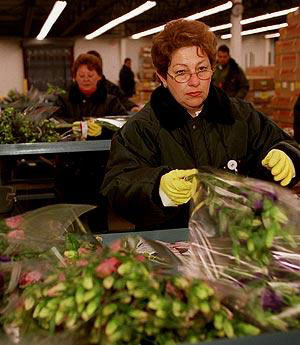Human Flower Project
Tuesday, October 17, 2006
Dole Dents South American Flower Industry
With U.S. cut flower sales declining, South American firms plead and fold.
A pair of recent stories both point to the fickle fortunes of those in the cut flower business, especially in South America. First, Dole Foods announced its subsidiary Dole Fresh Flowers would close all its flower farms in Ecuador and two in Colombia. In what sounds like a euphemism, one report described the decision as “impacting 2188 employees” in those two countries. Dole is—or was—the biggest fresh flower producer in Latin America.
John Amaya, DFF president, announced, “The fresh flower business is highly fragmented and competitive. Industry oversupply has driven prices down, creating significant pressure on growers to improve performance. Latin American growers are also facing new competition from emerging markets in Africa and Asia,” It appears that Dole will concentrate on a narrow range of flower types, varieties which, for one reason or another, Kenyan and Chinese growers don’t have the hang of—yet. Meanwhile the DFF sales force will be cut by 35%, management by 29%.
This is more than hard pruning.
 Nancy Acosta sorting flowers at Dole’s Miami facility, 2002
Nancy Acosta sorting flowers at Dole’s Miami facility, 2002
Photo: Nuri Vallabona,
for Miami Herald
In Miami, with word of the layoffs at Dole Fresh Flowers, labor activists called for an immediate protest in front of the company’s headquarters, “saying Amaya and Dole failed to meet farmworker demands for collective bargaining agreements. In Colombia, one union activist questioned why Dole selected (to close down) Splendor farm, which has been the center of a bitter unionizing campaign.
“‘It’s way too early for me to give a full reaction,’ said Rhett Doumitt, the Solidarity Center representative for the Andean region, who is based in Bogota. ‘We need to see why they chose the one farm that has really unionized.’”
Oversupplies, unfortunately, have coincided with decreased U.S. demand, according to Ernest Velez, chairman of Asocolflores, the Colombian Flower Exporters Association. “We need to increase the per capita consumption and grow the pie, rather than fight over smaller slices,” said Velez, speaking last week at Texas A&M University. “We need Americans to buy more flowers more often.” While Colombia, Ecuador, Kenya, and Holland grow 83% of the world’s cut flowers, said Velez, Germany, the United Kingdom, the U.S., Holland and France buy 75% of imported all cut flowers.
As part of his pitch for boosting U.S. sales, Velez stressed the measures some South American firms are taking toward safer working conditions, higher wages and more environmentally sound growing practices.
But are U.S. consumers really buying fewer flowers because they’re concerned about workers in Ecuador? Or let’s put it another way, would they buy more flowers knowing that those flower workers were well paid and foreign firms were taking good care of the environment? Talk to rug buyer and a coal miner before answering.




